Wondering what to do with all those leaves that are falling? Turn them into something useful - leaf mould.
Leaf mould is the leaf litter that you would typically find on the ground when going for a walk in the woods. Whilst it doesn't have a lot of nutrients, as it's comprised of dried leaves, it is an excellent soil conditioner, adding structure to the soil, whether your garden soil is heavy clay or light and sandy. It is also great for seed and potting compost and as a mulch for woodland or ericaceous plants in the garden. Mixed with grit, leaf mould is ideal for bulbs.
Left on the lawn, if thick enough, leaves will prevent daylight reaching the grass, trapping moisture, weakening the grass and encouraging the spread of moss. Leaves on the top of pots, containers and borders will create hiding places for slugs and snails as well as smother herbaceous perennials causing them to rot. Leaves left on the path and patio will encourage algae. So it's best to clear them up, the sooner the job is started, the easier it is to do. Leaves left to get wet and start to deteriorate are harder to collect.
Old, fallen leaves have little or no nitrogen remaining in them. Bacteria feed off of the nitrogen in plant material, so consequently can't break the leaves down. It is fungus that cause the old leaves to rot, in a cold, anaerobic (without oxygen) process, which takes a lot longer than regular composting which is aerobic (with oxygen). Unlike composting, leafmould doesn't need to be 'turned' as you don't need to keep putting oxygen into the heap. Although it's worth checking every month or so that there aren't any dry areas as this will stop the rotting down.
Although fallen leaves can be mixed with nitrogen rich material in a compost heap, the usual amount of leaves we get in one go, would swamp a typical compost heap both in terms of the volume and the amount of carbon/brown material. It's therefore better to keep the two processes apart.
Steps to make leaf mould:
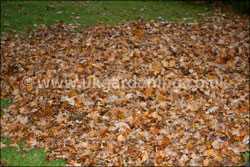 On a still autumn day, collect the leaves with a garden rake or leaf blower into a loose pile on a small area on the lawn.
On a still autumn day, collect the leaves with a garden rake or leaf blower into a loose pile on a small area on the lawn.
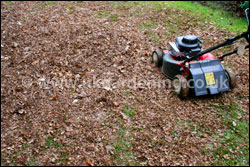 I then run over the leaves a few times with my lawnmower - set on its highest setting and with the grass box removed. This spreads the leaves out a bit, but it doesn't take too long to rake them back into a pile.
I then run over the leaves a few times with my lawnmower - set on its highest setting and with the grass box removed. This spreads the leaves out a bit, but it doesn't take too long to rake them back into a pile.
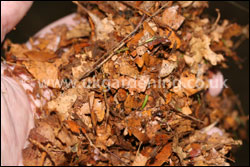 Shredding the leaves like this speeds up the rotting process. Leaves left in the garden, rot down naturally in about 2-3 years, chopped leaves in about 18-24 months, wet chopped leaves in a black bag can be used in 12-18 months. Shredding the leaves also reduces the amount of space needed to store them.
Shredding the leaves like this speeds up the rotting process. Leaves left in the garden, rot down naturally in about 2-3 years, chopped leaves in about 18-24 months, wet chopped leaves in a black bag can be used in 12-18 months. Shredding the leaves also reduces the amount of space needed to store them.
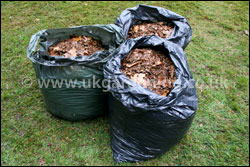 Pile the leaves/shreadings into black bin liners, add some water to make sure the leaves are wet, but not soaking, tie the top of the bag, poke some holes in the side of the bags with a garden fork and store them in a sheltered area.
Pile the leaves/shreadings into black bin liners, add some water to make sure the leaves are wet, but not soaking, tie the top of the bag, poke some holes in the side of the bags with a garden fork and store them in a sheltered area.
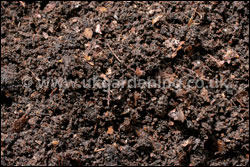 In 18-24 months (12-18 months if you've chopped them up) you should have some nice crumbly leaf mould, ready to use.
In 18-24 months (12-18 months if you've chopped them up) you should have some nice crumbly leaf mould, ready to use.
If you have a lot of leaves, make a semi-permanent open sided leaf bin (the bigger the better, something like 4ft x 4ft), 4 posts wrapped with chicken wire is sufficient. Position this in a secluded area of the garden or under a tree so it gets a bit of rain, but doesn't get too wet. If it's in the open, cover the top with plastic sheeting, weighted down with bricks or logs. Water if the pile gets too dry.
Leaf mould can be used as part of a homemade potting compost, mix with loam, compost and grit. Sieve in a fairly open sieve, anything that doesn't go through can go back onto the leaf bin.
When mulching around trees and shrubs with leaf mould it's easiest to add it to the borders with your hands, spreading it around as far as you can.
Don't add pine needles or conifer cuttings to your leaf mould pile as they take a lot longer to break down, up to 4 years. Compost them separately in the same way as making leaf mould and you'll have an acidic compost ideal for spreading around ericaceous plants.
Lilies really like leaf mould, so apply a thick mulch after planting and during the summer. Also add plenty of leaf mould if growing lilies in pots.
Use leaf mould as a mulch in the autumn. Particularly with woodland plants, like anemones and hellebores, as it has an open structure, but is not high in nutrients.
Other gardening how to pages:
- Growing plants from seed
- Create a hanging basket
- Laying a new lawn
- Making leaf mould
- Chitting and growing potatoes
- Care of Hippeastrum/Amaryllis after flowering
- Cleaning patios, paths and decking
- Removing large branches
- Creating a compost heap
- Moving a tree or large shrub
- Fencing and trellis
- Building a rockery
- Planting a winter basket
- Building a pond
- Make a large spirit level
